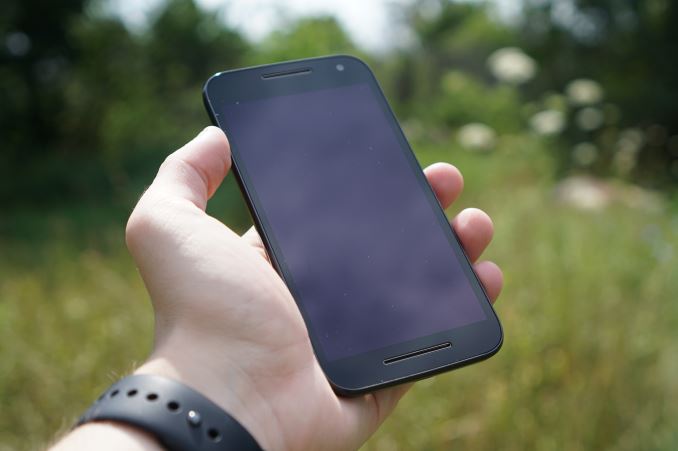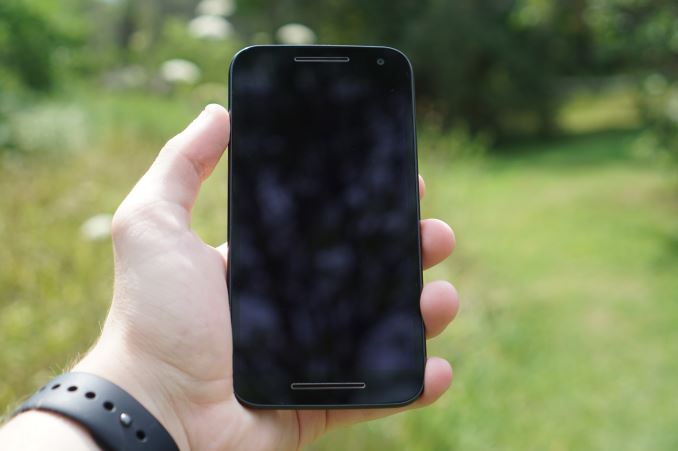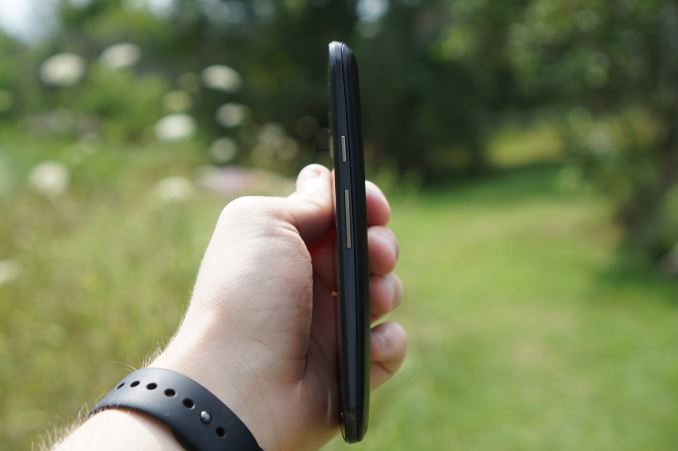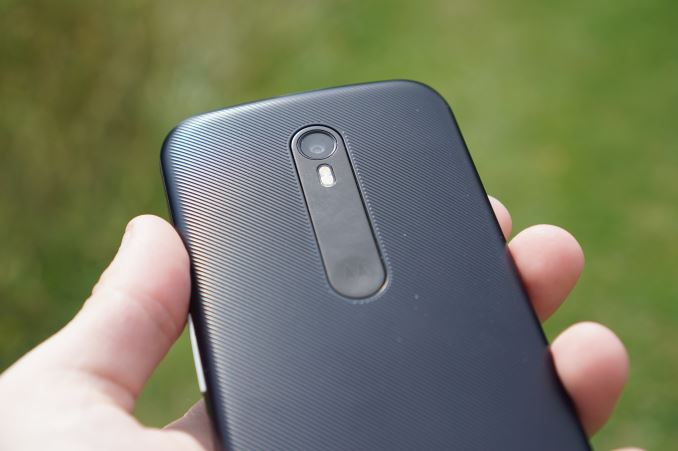The Moto G (2015) Review
by Brandon Chester on August 19, 2015 8:00 AM EST- Posted in
- Smartphones
- Mobile

Motorola's original Moto G was one of the first Android devices to offer what one could honestly call a good user experience at a price of around $200. It had a 4.5" 720p display, Qualcomm's Snapdragon 400 SoC, a 5MP rear camera, 1GB of RAM, and 8GB of memory. Since that time, Motorola has adopted a structure where their Moto E fills in the sub $150 range, the Moto G hovers around $200, and the Moto X acts as a several hundred dollar flagship device, although the dual Moto X launch for 2015 changes this slightly. In early 2014 we saw Motorola refresh the Moto G with support for LTE, and later in the year they did a more major refresh which bumped the display size to 5", the camera resolution to 8MP, and added the microSD slot from the LTE model of the original version.
While Motorola's 2014 refresh of the Moto G was technically a major update as far as their yearly cadence was concerned, many aspects of the phone remained the same. There was no change to the SoC or the amount of RAM, no change to the display resolution or connectivity, and no change to battery capacity. The early 2015 launch of the Moto E made things even stranger, as it shipped with some specifications that actually outclassed the Moto G, such as Qualcomm's Snapdragon 410 SoC. This put Motorola in a strange situation, which has finally been resolved with the new 2015 model of the Moto G. In my view, this is the first truly major update that the phone has seen since the original version, and you can see what improvements Motorola has made in the chart below.
| Moto G (2014) | Moto G (2015) | |
| SoC | Snapdragon 400 1.2 GHZ A7 | Snapdragon 410 1.4 GHz A53 |
| RAM | 1GB | 1/2GB |
| NAND | 8GB NAND + microSD | 8/16GB NAND + microSD |
| Display | 5” 720p IPS |
5” 720p IPS |
| Network | 2G / 3G / 4G LTE | 2G / 3G / 4G LTE (Category 4 LTE) |
| Dimensions | 141.5 x 70.7 x 11mm, 149g | 142.1 x 72.4 x 6.1-11.6mm, 155g |
| Camera | 8MP Rear Facing (Sony IMX179) f/2.4, 1.4 micron 1/3.2" sensor | 13MP Rear Facing (Sony IMX214) f/2.0, 1.1 micron 1/3.06" sensor |
| 2MP Front Facing | 5MP Front Facing | |
| Battery | 2070 mAh (7.87 Whr) | 2470 mAh (9.39 Whr) |
| OS | Android 4.4 (At Launch) | Android 5.1 (At Launch) |
| Connectivity | 2.4 GHz 802.11b/g/n + BT 4.0, USB2.0, GPS/GNSS |
2.4 GHz 802.11b/g/n + BT 4.0, USB2.0, GPS/GNSS |
| SIM | MicroSIM | MicroSIM |
| Launch Price | $179 (1GB/8GB) | $179 (1GB/8GB) $219 (2GB/16GB) |
As you can see above, this year's iteration of the Moto G brings along some significant improvements. For the first time ever, we're seeing an update to the Moto G's SoC. While both the first and second generation models used Qualcomm's Snapdragon 400 SoC with four 1.2GHz Cortex A7 cores, this year's model adopts a 1.4GHz version of Snapdragon 410 with four Cortex A53 cores. The battery also receives a hefty bump in capacity, although this does come along with an increase in height, width, and thickness, as well as a slight increase in mass. Memory remains the same for the base model at 8GB of NAND and 1GB of RAM, but an extra $40 bumps that to 16GB of NAND and 2GB of RAM.
The rear-facing camera moves from Sony's IMX179 sensor to IMX214 which interestingly enough is the same improvement that was made going from the Nexus 5 to the Nexus 6. The sensor size increases from 1/3.2" to 1/3.06", and the resolution is bumped to 13MP from 8MP. This means that pixel size drops from 1.3 micron to 1.12, and low light scenarios may see a reduction in image quality as a result, but the wider F/2.0 aperture can help to offset this. The front-facing camera also jumps from a 2MP to a 5MP sensor.
Connectivity and the display don't see any improvements with this upgrade. We're still looking at a 5" 1280x720 IPS display, and with WiFi and Bluetooth you get 2.4GHz 802.11n and Bluetooth 4.0 LE.
Design
At this point, Motorola's industrial design is fairly well known and understood. All of their devices, from the Moto E all the way up to the Nexus 6, have essentially the same chassis shape with differing dimensions. The big difference between Motorola's devices is the materials that are used. While Moto Maker allows users to customize their devices to some extent, more expensive devices may have special options like wood back covers, and may have metal frames around the chassis rather than plastic ones. Being a mid-range smartphone, the Moto G is made primarily of plastic.
When it comes to the front face and sides the 2015 Moto G continues to share a design with Motorola's other devices. It has speakers sitting above and below the display, and a front facing camera sitting to the right of the upper speaker. The sides are flat on the edge that meets the display, and curved on the edge that meets the back cover. Both the power button and volume rocker are located on the right side of the phone, and the power button has the same texture to it as the Nexus 6 and Moto E, which makes it easy to tell apart from the volume rocker. Something that does concern me a bit about the sides of the device is the large gap between the back cover and the rest of the device. There are points where the gap is wide enough that you can feel it decreasing in size when you grip the phone in that area, which concerned me both because it negatively impacts the feel of the device, and because the Moto G is supposed to be waterproof.
The back of the 2015 Moto G is where things depart slightly from how Motorola devices usually look. On older Motorola devices, the rear-facing camera sat above a small indent which had the Motorola logo inside it. The camera flash either sat between the logo and the camera, or was integrated into the ring around the camera itself. All of these features were separate and sat flush with the back cover. The new Moto G and Motorola's recently launched Moto X devices now have a strip which connects the camera, flash, and Motorola logo and puts them slightly below the level of the back cover.
Since the Moto G can be customized with Moto Maker, there will potentially be differences between a consumer's device and the review unit I have. In my case, the Moto G's back cover is made of black plastic, with a series of raised diagonal lines which gives it a different feeling from a device with a smooth back like the Moto E. I personally prefer the in hand feel of this back cover to the smooth slippery plastic on the Moto E, and I think the black color goes very well with it.
As I mentioned earlier, the Moto G is waterproof. Its IPX7 rating specifies that it can be submerged up to 1 meter deep for up to thirty minutes. While I didn't push the device to that limit just due to worries about possibly damaging a review unit, I did put it under thirty centimeters of water for around twenty minutes and it did not sustain any damage. All back covers for the third generation Moto G have plastic sections that fit into and protect the open ports on the back of the phone from any water getting in. While there was absolutely no damage, you can see above that water was able to get between the back of the chassis and the back cover even though I made sure to secure the back cover tightly and properly. I don't believe this to be any cause for concern, but I felt it was worth sharing. With a removable back cover this issue can't really be avoided, and the inserts that block important ports have kept water out of the areas that need to be protected.
In the end I think the 2015 Moto G has a good feel in the hand, and I think the build quality is more than acceptable for a phone that starts at $179. I definitely prefer the textured back cover to the smooth and slippery ones on some other Motorola phones, and if you're given that option I would definitely opt for it. My only complaint is that the back cover doesn't attach as tightly to the phone as I would like, and you can notice the gap when you touch it at the edges. The gap also seems to be big enough to let water through, but the protective covers on the back cover ensure that the phone won't get damaged.















90 Comments
View All Comments
Cod3rror - Wednesday, August 19, 2015 - link
I wish Motorola hadn't released two different versions (1GB / 2GB). I knew what would happen and what I expected is exactly what happened... almost all retailers and carriers in Europe/UK are stocking only the 1GB version and 2GB is nowhere to be found. Plus, because of the weak Euro, the 2GB version, if ordered from Motorola UK, comes out at 300 euro, which is very expensive. But don't get me wrong, even if it cost almost the same, the retailers and carriers would still stock the cheaper version.dan.swain - Saturday, September 12, 2015 - link
I agree with you, My wife has the Moto G 2015 16GB. Got it from Moto website the sales experience was terrible but I couldn't just buy the 16Gb in a shop so frustration ensued. The phone itself is great though, my wife can get multiple days out if it. At just over £200 it seemed a better deal than £200 Apple wanted for a refurbished IPhone 5c.wurizen - Wednesday, August 19, 2015 - link
It seems like this review confirms my suspicion of the new Moto G 2015 regarding the back cover flush gate. Feeling the back cover of a phone inch forward or push inwards when gripping it is a sign of a cheap phone to me. And we know that this is a cheap, budget phone, but, the Moto G 2014 doesn't have this issue. I am also looking at the profile picture of the Moto G 2015 and it looks bulkier than the Moto G 2014. Or it seems bulkier because the removable back cover of the 2015 is not halfway but below the Power and Volume buttons. Whereas, the Moto G 2014's back cover is exactly halfway from front to back, so it goes halfway up from the Power and Volume buttons making the phone--on a design perspective--look and feel balanced!What makes me sad is that I don't think Motorola had to sacrifice this decrease in "Phone Feel" and "Phone Ergonomics" or "Phone Design." Whatever you wanna call it.
I mean, did the design of the Moto G 2015 change because Motorola wanted it to be waterproof? Or, did Motorola purposely make a fatter Moto G 2015 so people will buy their other more expensive phones? Let the conspiracy theories begin!
My other gripe is that Best Buy, which is the only store I know in the U.S. that carries the Moto G unlocked version doesn't even have the new Moto G 2015 on display so customers can feel and hold it in their hands. I mean, imagine Samsung or Apple doing this? It would never happen. Yet, Motorola is letting Best Buy not have a display version. I also asked if they had the phone on sale and if they could open a box and let me hold one. But, they said that they didn't have any available. I then asked if they had sold out and they said, yes.
Also, there is no white version available at Best Buy and no 2 GB/16 GB variant available. Just the 1GB RAM and black one.
Can someone tell me why this is? What kind of marketing scheme is at work here?
Demon-Xanth - Thursday, August 20, 2015 - link
The reason why no 2/16 variant is that they are basically sold out everywhere. I'm guessing production focused on the black 1/8 due to anticipated demand. They aren't mythical devices. Just selling like cold beer at a county fair. Yes, I will be replacing my ATT XT1045 with a retail 2/16 when I can. The only problems I've had have been I'd like more RAM, a better camera, less "extra apps", and updates that aren't delayed until the second coming of christ. This covers all of them.stlc8tr - Wednesday, August 19, 2015 - link
"I don't think anyone buying a device like the Moto G will have adopted an 802.11ac router at this point anyway due to cost reasons."An AC router is roughly $75 on Amazon. It's not exactly a huge outlay so I think more points should be deducted for the lack of 5Ghz support. The 2.4Ghz band can be very crowded so being limited to only 2.4Ghz is a serious flaw, IMO.
Moto1 - Wednesday, August 19, 2015 - link
Dude, its 179$. Seriously?stlc8tr - Thursday, August 20, 2015 - link
Yes, I'm serious. In my neighborhood, there are so many 2.4Ghz WiFi networks that using my 2.4Ghz WiFi is hit or miss. I can't even use a Chromecast as the streaming times out half the time.So I avoid any devices that are 2.4Ghz only.
neogodless - Wednesday, August 19, 2015 - link
As this is a phone, could you comment on the speaker quality at all? It sounds like it still has stereo speakers like the 2014 model. Are they the exact same?hans_ober - Wednesday, August 19, 2015 - link
They're not stereo, bottom is a loudspeaker.neogodless - Tuesday, August 25, 2015 - link
That's too bad! The 2014 had stereo. In the search for "no compromises" including stereo speakers, I ended up with a Nexus 6.